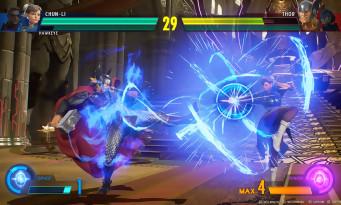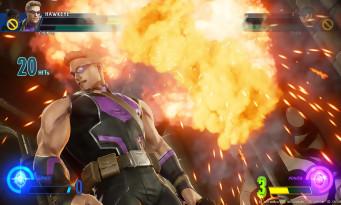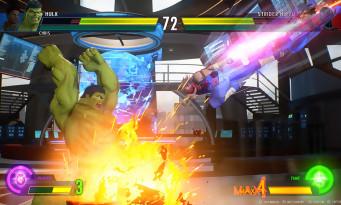 Because it's been over six years now that Marvel vs. Capcom 3 is out, and even though the tag team is still a must in Infinite, the developers decided to reduce the number of fighters on screen. Suddenly, we end up with only four characters, which in no way affects the dynamism of the game. In fact, the primary goal was to make the clashes more readable, less messy, which many players criticized MvC3 for. And then, there is also this supposed synergy between the two partners which explains the end of threesomes. For what result, in the end? Well, it's true that Marvel vs. Capcom Infinite is generally clearer than its predecessor, especially since the strikers were rejected by Capcom's teams. Nevertheless, even at four, when the combos drag on and the big attacks follow one another, it can sting the eyes. In any case, laymen will no longer have the impression of being snubbed, especially since Infinite has considerably simplified certain commands. We reassure you, the Shoryuken still runs the old way, but clubbing LP allows you to slam an Auto Combo, whether on the ground or in the air. There is also a second sequence common to all characters (LP, LK, HK, bas+HP) and which ends with a launcher. A welcome gateway for beginners who would like to get started gently.
Because it's been over six years now that Marvel vs. Capcom 3 is out, and even though the tag team is still a must in Infinite, the developers decided to reduce the number of fighters on screen. Suddenly, we end up with only four characters, which in no way affects the dynamism of the game. In fact, the primary goal was to make the clashes more readable, less messy, which many players criticized MvC3 for. And then, there is also this supposed synergy between the two partners which explains the end of threesomes. For what result, in the end? Well, it's true that Marvel vs. Capcom Infinite is generally clearer than its predecessor, especially since the strikers were rejected by Capcom's teams. Nevertheless, even at four, when the combos drag on and the big attacks follow one another, it can sting the eyes. In any case, laymen will no longer have the impression of being snubbed, especially since Infinite has considerably simplified certain commands. We reassure you, the Shoryuken still runs the old way, but clubbing LP allows you to slam an Auto Combo, whether on the ground or in the air. There is also a second sequence common to all characters (LP, LK, HK, bas+HP) and which ends with a launcher. A welcome gateway for beginners who would like to get started gently.
If the return to 2 vs. 2 is beneficial for the readability of the fights, if the gameplay is both accessible and deep as soon as you start poking around in the Infinity Stones and working on the synergies between the characters, the game wallows on the other hand on the “History” mode whose insipidity is simply scandalous.
 Another point that may make purists cringe: the Hyper Combos. Unlike other Marvel vs. Capcom, it is no longer necessary to bother with quarter circles: simultaneously pressing HP and HK is enough to release a big attack. That's not all, because as soon as you understand that you can abuse the Active Switch - in other words, change characters during the fight - without the slightest constraint, you quickly get an idea of the butcher shop which is announced behind. Because if Marvel vs Capcom Infinite wants to be accessible, it is also the guarantee for fans to get out of the lunar phases with a string of hits, especially since the game is quite indulgent in terms of timings. Anyway, as we said a few months ago, Tatsunoko vs. Capcom may have served as a model as the rhythm is unbridled in Infinite. Afterwards, a few subtleties have been slipped here and there, just to not spit on those who have fed Capcom's portfolio for all these years. For example, there is the Counter Switch which breaks the opponent's combo in exchange for two bars of Hyper. We could also talk about the Advancing Guard (Fist + Kick) which, in addition to pushing the opponent back, reduces the effects of chip damage.
Another point that may make purists cringe: the Hyper Combos. Unlike other Marvel vs. Capcom, it is no longer necessary to bother with quarter circles: simultaneously pressing HP and HK is enough to release a big attack. That's not all, because as soon as you understand that you can abuse the Active Switch - in other words, change characters during the fight - without the slightest constraint, you quickly get an idea of the butcher shop which is announced behind. Because if Marvel vs Capcom Infinite wants to be accessible, it is also the guarantee for fans to get out of the lunar phases with a string of hits, especially since the game is quite indulgent in terms of timings. Anyway, as we said a few months ago, Tatsunoko vs. Capcom may have served as a model as the rhythm is unbridled in Infinite. Afterwards, a few subtleties have been slipped here and there, just to not spit on those who have fed Capcom's portfolio for all these years. For example, there is the Counter Switch which breaks the opponent's combo in exchange for two bars of Hyper. We could also talk about the Advancing Guard (Fist + Kick) which, in addition to pushing the opponent back, reduces the effects of chip damage.
AND MORE SO INFINITE
 But the major innovation is obviously the Infinity Stones (six in number) which are reminiscent of Capcom's Groove system vs. SNK. Clearly, depending on the GEM that we will choose, the "powers" of our character will be different, knowing that we will have to juggle between the Infinity Storm (a power specific to the stone used) and the Infinity Surge (a special move that increases Storm's gauge). Thus, those who bet on the stone of Power will be able to bounce their opponents and initiate juggles more easily with the Infinity Surge, while the Infinity Storm will increase the power of the blows tenfold. The Space Stone, for its part, will offer the possibility of attracting the adversary towards oneself and, if necessary, of locking him in a block of crystal to better chain him. On the Time side, fans of dashes will be served, and if we decide to activate the Infinity Storm, the speed of execution of the character will be better with no recovery frame and greater freedom in the combos. Regarding the Reality Gem, there will be a way to eat the brain of the player opposite with projectiles that will go directly towards him, and elemental attacks with variable effects. As for the Soul Stone, it has the advantage of resuscitating our partner with the Infinity Storm; for unlikely turnarounds, Capcom couldn't do better. Finally, there is the stone of the Spirit which allows you to ring the opponent - and to expose him, suddenly, to a devastating combo - without forgetting the Hyper Combo gauge which regenerates quietly.
But the major innovation is obviously the Infinity Stones (six in number) which are reminiscent of Capcom's Groove system vs. SNK. Clearly, depending on the GEM that we will choose, the "powers" of our character will be different, knowing that we will have to juggle between the Infinity Storm (a power specific to the stone used) and the Infinity Surge (a special move that increases Storm's gauge). Thus, those who bet on the stone of Power will be able to bounce their opponents and initiate juggles more easily with the Infinity Surge, while the Infinity Storm will increase the power of the blows tenfold. The Space Stone, for its part, will offer the possibility of attracting the adversary towards oneself and, if necessary, of locking him in a block of crystal to better chain him. On the Time side, fans of dashes will be served, and if we decide to activate the Infinity Storm, the speed of execution of the character will be better with no recovery frame and greater freedom in the combos. Regarding the Reality Gem, there will be a way to eat the brain of the player opposite with projectiles that will go directly towards him, and elemental attacks with variable effects. As for the Soul Stone, it has the advantage of resuscitating our partner with the Infinity Storm; for unlikely turnarounds, Capcom couldn't do better. Finally, there is the stone of the Spirit which allows you to ring the opponent - and to expose him, suddenly, to a devastating combo - without forgetting the Hyper Combo gauge which regenerates quietly.
But the major innovation is obviously the Infinity Stones (six in number) which are reminiscent of Capcom's Groove system vs. SNK.
 So, it's up to you to see which Stone suits you best, the goal obviously being to create associations capable of reducing the weaknesses of each other. Compensating for Thor's slowness with the Time Gem can be a good idea, for example, but nothing prevents you from emphasizing his power with the Power Stone. You will have understood it, with the 2 vs. 2, the combinations are multiple and this is certainly what will interest the old-timers to make the difference. Like any other fighting game at the time of its release, Marvel vs Capcom Infinite does not escape the debate on its tier list. Of course, we cannot currently designate with certainty the S+ and the D, and we will avoid relying on the MvC3 ranking. Afterwards, given what we have seen, it would still be surprising if Dante was not top tier, just like Strider, with whom Sparda's son gets along wonderfully when they team up. The famous synergy, remember? Well, Infinite containing 30 characters, we haven't tried all the possible pairs either, and we prefer to leave this task to the pros who are used to being invited to EVO.
So, it's up to you to see which Stone suits you best, the goal obviously being to create associations capable of reducing the weaknesses of each other. Compensating for Thor's slowness with the Time Gem can be a good idea, for example, but nothing prevents you from emphasizing his power with the Power Stone. You will have understood it, with the 2 vs. 2, the combinations are multiple and this is certainly what will interest the old-timers to make the difference. Like any other fighting game at the time of its release, Marvel vs Capcom Infinite does not escape the debate on its tier list. Of course, we cannot currently designate with certainty the S+ and the D, and we will avoid relying on the MvC3 ranking. Afterwards, given what we have seen, it would still be surprising if Dante was not top tier, just like Strider, with whom Sparda's son gets along wonderfully when they team up. The famous synergy, remember? Well, Infinite containing 30 characters, we haven't tried all the possible pairs either, and we prefer to leave this task to the pros who are used to being invited to EVO.
THE WORLD IS STONE
 We will rather dwell for a few moments on the “Story” mode of Marvel vs Capcom Infinite which, oh surprise, is inspired by NetherRealm productions (Mortal Kombat, Injustice). We therefore embody different superheroes, all interspersed with cutscenes and dialogues that did not thrill us more than that. The single-player campaign takes just four hours to complete, and to be honest, there's not much to take away. In fact, yes: the endless loading times which, put end to end, probably total a good fifteen minutes. Mind-blowing. For the rest of Infinite's content, it's classic with the "Arcade" and "Versus" modes, the online game (closed at the time of writing this test), as well as the Challenges which allow you to revise the basics of the game at the same time. To conclude on an artistic note, the realization of Infinite is not really at the top. Blame it on a failed character design – whether Marvel or Capcom characters – and school sets. However, the idea of offering internships resulting from a merger between the two universes was good on paper (Asgard + Mega Man X = Xgard, for example), but the pencil stroke is not at all inspired. Fortunately, it moves well and the visual effects are there to reinforce the impact of the blows. In any case, we expected much more from the Unreal Engine 4 with which Marvel vs Capcom Infinite is sorely lacking in character.
We will rather dwell for a few moments on the “Story” mode of Marvel vs Capcom Infinite which, oh surprise, is inspired by NetherRealm productions (Mortal Kombat, Injustice). We therefore embody different superheroes, all interspersed with cutscenes and dialogues that did not thrill us more than that. The single-player campaign takes just four hours to complete, and to be honest, there's not much to take away. In fact, yes: the endless loading times which, put end to end, probably total a good fifteen minutes. Mind-blowing. For the rest of Infinite's content, it's classic with the "Arcade" and "Versus" modes, the online game (closed at the time of writing this test), as well as the Challenges which allow you to revise the basics of the game at the same time. To conclude on an artistic note, the realization of Infinite is not really at the top. Blame it on a failed character design – whether Marvel or Capcom characters – and school sets. However, the idea of offering internships resulting from a merger between the two universes was good on paper (Asgard + Mega Man X = Xgard, for example), but the pencil stroke is not at all inspired. Fortunately, it moves well and the visual effects are there to reinforce the impact of the blows. In any case, we expected much more from the Unreal Engine 4 with which Marvel vs Capcom Infinite is sorely lacking in character.


























